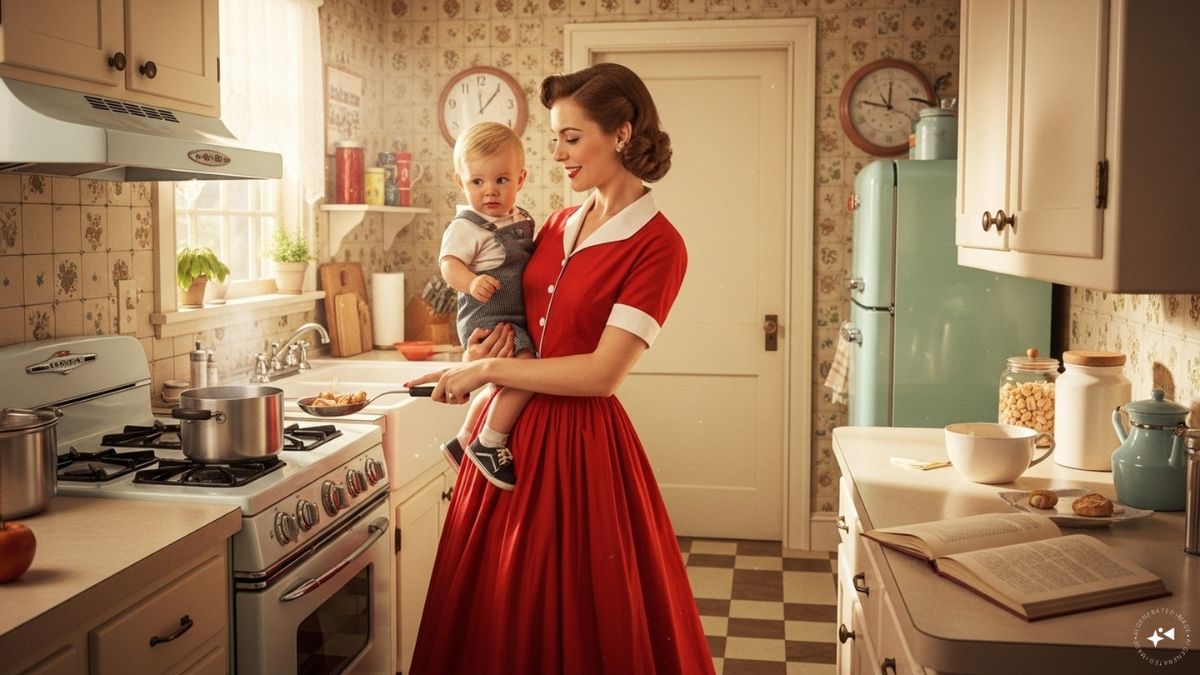“Tradwife” and “skibidi” are among the popular slang terms on the internet that will be included in the Cambridge Dictionary this year. Tradwife is a portmanteau for “traditional wife”, while skibidi is a gibberish word that can have different meanings, “such as ‘cool’ or ‘bad’, or can be used with no real meaning as a joke,” as per the dictionary.
Over 6,000 new words have been added to the Cambridge Dictionary . “Internet culture is changing the English language and the effect is fascinating to observe and capture in the dictionary,” lexical programme manager Colin McIntosh said.
The inclusion of tradwife shows how the term has increasingly caught the attention of the internet. But what is it?
We will explain.
What does tradwife mean?
Tradwife is a married woman who conforms to traditional gender roles, focusing on the home by cooking, cleaning and raising the kids, while her husband is the primary breadwinner and provider.
The term is used for women who live and encourage such a lifestyle on social media by creating appealing content. They basically sell the lives of traditional 1950s housewives, berate feminism and promote submission to husbands.
“Traditional wife” is a “very particular social media phenomenon happening right now where women are highlighting a version of being a wife where the woman is submissive to a man and stripped of her agency in order to cater to his needs,” Jo Piazza, who hosts a podcast about influencers, Under the Influence, was quoted as saying by PopSugar.
Rise of tradwives online
Those following the tradwife trend build up their lives around the outdated notion that women should prioritise domesticity over careers and education.
#Tradwife content has taken social media by storm. These mostly Caucasian “traditional wives” give a sneak peek into their perfectly aesthetic lives. Donning long, modest dresses, these women can be seen preparing meals for their families from scratch. They also prioritise beauty – maintaining a “feminine” appearance – to attract their husbands.
Impact Shorts
More ShortsTheir smiling kids are playing outdoors, while the houses are immaculately kept.
Hannah Neeleman, the woman behind the Instagram account ballerinafarm, creates popular tradwife content. She is a Juilliard-trained ballerina who gave up her dream to be a professional dancer after marriage.
The woman enjoys idyllic farm life, bakes bread for family, plays with her kids outside and has a successful farm business. She can afford not to work, though.
Her husband comes from immense wealth. So, while her lifestyle may be aspirational for some, many cannot choose to live her way, owing to a lack of such fortune.
Victoria Yost is another tradwife. She wakes up at 8.30 am, enjoys time with her child, prepares meals for the family and cleans up the house.
Yost posts such “day in the life” videos for her more than two lakh followers on TikTok, which has thousands of videos with the #tradwife hashtag.
The majority of these women are Mormon and trace their beliefs to their Christian faith. Popular tradwife accounts try to portray their submission as empowerment.
“Remember when women cooked real meals and families were healthy? Since feminism told us the kitchen was a prison, obesity has exploded. Traditional families—where mothers cook and care—don’t deal with this sickness. Today’s women can’t even fry an egg, but call it progress,” a post on Instagram reads.
Tradwife vs stay-at-home moms
Tradwives and stay-at-home moms are not the same. The emphasis on submission is a key distinction between the two.
“Tradwives often promote a return to what they see as more ‘natural’ gender roles, which can sometimes be viewed as regressive or contrary to modern feminist ideals,” Meg Tibayan, parenting expert, told Parents website.
Stay-at-home moms may be doing it temporarily due to no child care or increasing costs of child care. On the other hand, tradwives appear to be permanently committed to the traditional gender roles.
The debate on tradwife trend
The tradwife trend has left the internet divided. While many find no issue with such content, others have lambasted it for romanticising the time when women performed thankless labour to keep their homes running.
It is also controversial as many people no longer conform to traditional gender roles.
These tradwives present life as stress-free, as they have a man to financially take care of the family.
Comments such as “I would love to stay at home and focus on my home. Sadly, the modern economy won’t let us,” sum up the feelings that tradwife content evokes in some viewers looking for a break from their real life.
“I do think that it’s dangerous to promote beautiful imagery linked to women giving up their agency and autonomy, not only because it is a false narrative about what life as a wife and mother is actually like, but because it idealises a world where a woman has very little ability to survive on her own,” Piazza said to PopSugar.
The tradwife movement is in no way innocent, as it has been shown to have been fanned by alt-right ideologies. “The tradwife movement’s link to alt-right ideologies presents a unique set of dangers that extend far beyond the surface appeal of its aesthetic and empowerment rhetoric. Influencers on social media platforms have been instrumental in packaging far-right populist movements as attractive content. Tradwives, as part of the alt-right community, strategically blend extremist politics with aesthetics of femininity, beauty and relationships,” according to Forbes.
Promoting such content also does a big disservice to women in parts of the world where they have to continue to fight for basic rights such as education. The tradwife trend is also influencing women to return to restrictive roles with no agency or money of their own, perpetuating inequality.
With inputs from agencies


)

)
)
)
)
)
)
)
)



